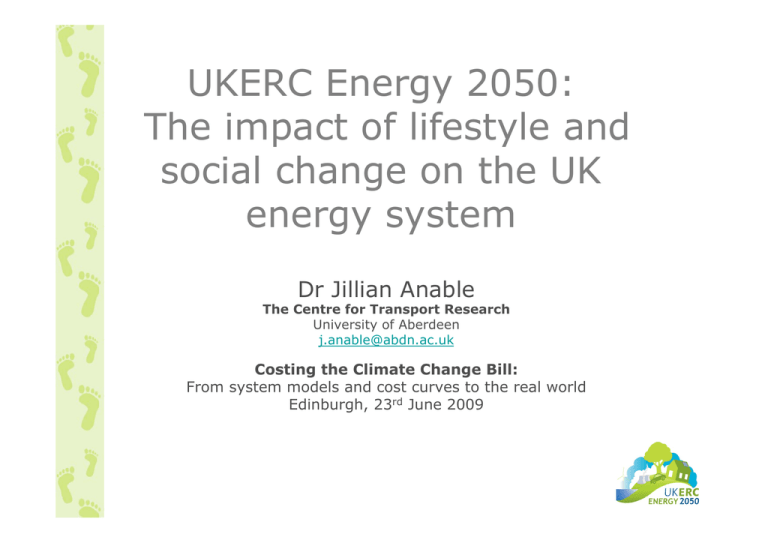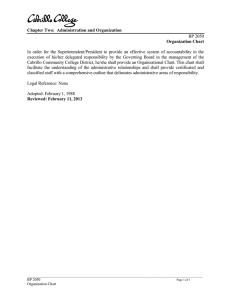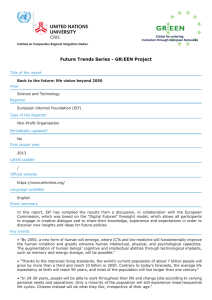UKERC Energy 2050: The impact of lifestyle and energy system
advertisement

UKERC Energy 2050: The impact of lifestyle and social change on the UK energy system Dr Jillian Anable The Centre for Transport Research University of Aberdeen j.anable@abdn.ac.uk Costing the Climate Change Bill: From system models and cost curves to the real world Edinburgh, 23rd June 2009 The Energy Lifestyles Scenario The project: One scenario in the UK Energy Research Centre project “Energy 2050” The aim: To understand the potential impact of ‘lifestyle change’ on the UK energy system on 2050, in particular carbon emissions and system resilience The team: Nick Eyre, Christian Brand, Russell Layberry (Oxford), Jillian Anable (Aberdeen), Neil Strachan (King’s, London) What are lifestyles? Various definitions Consumption patterns Preferences Use of time and space Social values and norms Public acceptance of technology and policy change Our focus Decisions that affect energy demand The lifestyle scenario Storyline: Socially led change in energy use Re-evaluation of ‘consumption’ ‘Green housing’; ‘community living’; ‘accessibility’, not ‘mobility’ Policy consistent with social norms Which behaviours: Household energy & personal transport Technology choice & use Scale of change: End points consistent with observed behaviour somewhere in OECD today Rates of change based on historically observed rates Lifestyle scenario methodology Income and population growth; International context Social norms, attitudes preferences, acceptance, consumption Modelling Output 1 Variants Story line Modelling Reference case UK Domestic Carbon Model UK Transport Carbon Model Energy Service Demands & Technology Choices MARKAL UK Energy System Model LS REF LS LC Low carbon case The Scenarios ENERGY SYSTEM ATTRIBUTES Lifestyle Low Carbon constraint REF Reference (“firm and funded” policies as of EWP 2007) LC “Low carbon” LS “Lifestyle” LS LC “Lifestyle low carbon” Household sector – lifestyle changes Internal temperature Hot water use Space heating Useful energy down 50% Light/applian ce ownership & use Water heating Useful energy down 40% Retrofit insulation Light/ appliance Useful energy down 37% Microgen 20 TWh in 2050 (30% of household electricity) Replacement heating systems Light/applian ce efficiency Microgeneration Household sector – impacts on energy demand Household useful energy demand - LS REF scenario 500 450 400 350 space_heat water_heat dla gas_appliances total TW h 300 250 200 150 100 50 20 49 20 46 20 43 20 34 20 37 20 40 20 31 20 28 20 25 20 22 20 19 20 13 20 16 20 10 20 07 20 04 20 01 ye ar 19 98 0 A combination of energy service demand reduction and efficiency improvement reduces energy demand by more than 50% from baseline levels by 2050. Household sector – impacts on heating systems Residential heating by fuel type in different scenarios (2000 and 2050) 1,800 1,600 Solar District heating / micro-CHP 1,400 Solid/wood fuel 1,200 Oil 1,000 PJ Coal Heat pumps 800 Electricity 600 Gas (instant) 400 Gas (condensing) Gas 200 2000 REF LS REF LC LS LC Up to 2025, the major change is market penetration of condensing boilers. By 2050 the sector is transformed in different ways Transport sector – lifestyle and mobility changes Accessibility Localism Slower speeds Compact cities Car-free zones Car clubs Total distance Down 21% Mode choice Car from 81 - 36% distance Cycle from 1 - 13% distance Vehicle choice Electric and hydrogen vehicles 77% vkms in 2050 Driving Style Ecodriving = 5% reduction in CO2 per km by 2025 Car Car occupancy up 23% by 2050 ICT Tele-working Tele-shopping Less air travel Policy acceptance Occupan cy Transport sector – impact on fuel demand Transport Fuel Demand in different scenarios (2000 and 2050) 2,500 Ethanol/methanol 2,000 Bio-diesel/kerosene Jet fuel PJ 1,500 Hydrogen 1,000 Electricity Diesel 500 Petrol - 2000 REF LS REF LC LS LC Impacts of lifestyle on the wider energy system Final Energy Demand by Fuel in different scenarios (2000 and 2050) 7,000 Others Heat Biomass Manufactured fuel Bio diesels Ethanol/Methanol Hydrogen Jet fuel 6,000 5,000 PJ 4,000 Diesel Petrol Coal Gas LPG Fuel oil Electricity 3,000 2,000 1,000 - 2000 REF LS REF LC LS LC Lifestyle reduces energy demand by ~30% by 2050 Implications for electricity supply Electricity generation mix in 2050 2,500 Storage Solar PV Marine 2,000 Imports Biowaste & others Wind 1,500 PJ Hydro Oil Nuclear 1,000 Gas CCS Gas Coal CCS 500 Coal - 2000 REF LS REF LC LS LC Lifestyle change increases the share of electricity in final demand, but it limits the scale of electrification to meet tough carbon targets. Cost implications Cost benefit comparison between scenarios with different lifestyle is not appropriate as preferences differ Increased investment in insulation ~£2bn per year Reduced energy supply system costs of £90bn per year in 2050 A low carbon energy system with lifestyle change is ~£90bn per year cheaper – 2.5% of projected GDP - in 2050 Conclusions Lifestyle change can produce a combination of energy service demand and technology change that: reduce energy demand in homes and transport by more than 50% below baseline levels by 2050 reduce national energy use and carbon emissions by ~30% below baseline change end use technologies to increase the share of electricity, but reduce the absolute increase in electricity demand reduce the cost of delivering a low carbon energy system by ~ £90 billion





